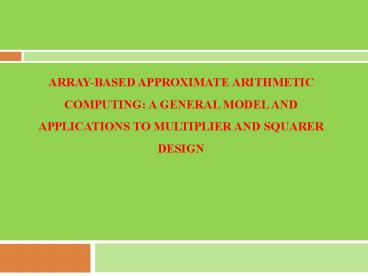IEEE 2015 VLSI ARRAY-BASED APPROXIMATE ARITHMETIC COMPUTING.pptx - PowerPoint PPT Presentation
Title:
IEEE 2015 VLSI ARRAY-BASED APPROXIMATE ARITHMETIC COMPUTING.pptx
Description:
PG Embedded Systems www.pgembeddedsystems.com #197 B, Surandai Road Pavoorchatram,Tenkasi Tirunelveli Tamil Nadu India 627 808 Tel:04633-251200 Mob:+91-98658-62045 General Information and Enquiries: g12ganesh@gmail.com – PowerPoint PPT presentation
Number of Views:10
Title: IEEE 2015 VLSI ARRAY-BASED APPROXIMATE ARITHMETIC COMPUTING.pptx
1
ARRAY-BASED APPROXIMATE ARITHMETIC COMPUTING A
GENERAL MODEL AND APPLICATIONS TO MULTIPLIER AND
SQUARER DESIGN
2
ABSTRACT
- A general model for array-based
approximate arithmetic computing (AAAC) is
proposed to guide the minimization of processing
error. As part of this model, the Error
Compensation Unit (ECU) is identified as a key
building block for a wide range of AAAC circuits.
The theoretical analysis is developed towards
addressing two critical design problems of the
ECU, namely, determination of optimal error
compensation values and identification of the
optimal error compensation scheme.
3
- To minimize energy consumption, delay and area of
AAAC circuits, ECU design is simplified by
introducing logic don't cares. By applying this
model and using a commercial 90 nm CMOS standard
cell library, an approximate 16x16 fixed-width
Booth multiplier is proposed that consumes 44.85
and 28.33 less energy and area compared with
theoretically the most accurate fixed-width Booth
multiplier. Furthermore, it reduces average
error, max error and mean squared error by
11.11, 28.11, and 25.00, respectively.
4
EXISTING METHODS
- 1. Constant correction and variable correction
schemes in approximate AND array multipliers. - 2.Estimation threshold calculation, and
self-compensation approach have been utilized to
compensate the truncation error. But it increases
the power consumption. - 3.Design of LUT based squarer, which increases
the area.
5
PROPOSED METHOD
- The AAAC model consists of three units
low-precision computing unit (LPCU), error
compensation unit (ECU), and combine unit (CU).
The LPCU in the AAAC circuit produces a
low-precision approximate output, for example,
based upon truncation or a fraction of the input
bits, with lowered energy, delay, and/or area
overheads compared with the error-free EFCU. To
reduce the error produced by the LPCU, a low-cost
ECU may be included for error compensation.
Finally, the CU combines the error compensation
produced by the ECU with the result outputted by
the LPCU, generating the final output of the AAAC
unit with reduced approximate error. The
multiplier and squarer is designed using this
proposed AAAC model.
6
(No Transcript)
7
ADVANTAGES
- Low area
- High Speed































